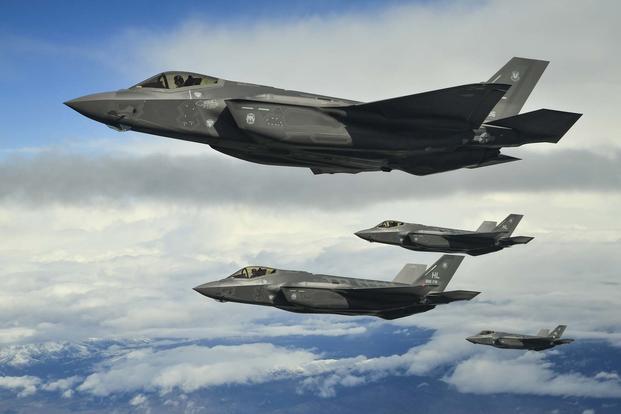Air Force Secretary Heather Wilson painted a grim picture two years ago of the eroding readiness levels plaguing her service in the wake of sequestration and budget cuts, including aircraft atrophying on flight lines and pilots getting too few flight hours.
It didn't mean that the Air Force wouldn't step up to fight in a conflict, she said. "It means fewer will come back. I think we need to understand that," she told reporters at the Pentagon in 2017.
But after plus-ing up end strength and distributing resources across the force, Wilson sounded more hopeful Thursday that the service is ready to "fight tonight."
"We are more ready for major combat operations today than we were two years ago, and more than 90 percent of our pacing squadrons, those squadrons that are required for either a China or a Russia fight, are ready to fight tonight with their lead-force packages," she told airmen at the Air Force Association's Air Warfare Symposium in Orlando, Florida.
Related content:
- The Air Force Has Fixed Its Active-Duty Maintainer Shortage, SecAF Says
- Shorter Contracts, Hefty Bonuses Available for Air Force Pilots
- Here's How the Air Force Hopes to Train 1,500 New Pilots a Year
Citing the National Defense Strategy, Wilson said "the Air Force will be at the forefront" of any new conflict, regardless of where or with whom.
In the last two years, the Air Force has added nearly 9,000 active-duty airmen to its end strength across squadrons that needed them most, she said. That includes the logistics, maintenance and cyber career fields.
Wilson reiterated recent comments that there is no longer a shortage of active-duty maintainers, with 4,000 positions filled in that same timeframe.
That said, "We've got a heck of a lot more work to do," she added.
For example, the Air Force added 1,200 new pilots -- roughly 150 more than expected -- last year, with the help of efforts like Pilot Training Next, a first-of-its-kind program that tests the ability of students to learn faster and absorb more through cutting-edge technology aids and cockpit simulators, Wilson said.
But the service has still come up short.
In written testimony before the Senate Armed Services subcommittee on personnel, Lt. Gen. Brian Kelly, deputy chief of staff for manpower, personnel and services, said Wednesday that the Air Force ended fiscal 2018 with a total force pilot shortage of 1,937.
The service said it was roughly 2,000 pilots short in 2017.
"Shortfalls in the fighter pilot inventory are the most acute," Kelly said, adding that airmen aren't overly interested in some of the offered bonuses.
"After four straight years of steady decline, the overall take rate for the aviation bonus stabilized and went up slightly from 44 percent in 2017 to 45 percent in 2018," he said. The "take rate," or accepted bonus, for fighter pilots increased from 35 percent to 44 percent, and bomber pilots went from 46 percent to 53 percent, he said.
"Unfortunately, we saw a decrease in our largest category, mobility pilots, where the take rate went down from 44 percent to 38 percent. Overall, we are below the retention target of 65 percent needed each year and within each pilot category to sustain a healthy inventory," Kelly said.
The Air Force is also rushing to reach 80 percent readiness levels in its F-16 Fighting Falcon, F-22 Raptor and F-35 Joint Strike Fighter communities, all while looking to add at least 74 additional squadrons over the next decade.
Then-Defense Secretary Jim Mattis issued a memo in September directing the Air Force and Navy to raise mission-capable rates for four key tactical aircraft to 80 percent by the end of fiscal 2019.
Wilson has pledged to get 204 of the service's 312 operational squadrons to 80 percent readiness by 2020, with the remainder reaching those levels by 2023, she recently told Defense News.
Chief of Staff Gen David Goldfein, Chief Master Sgt of the Air Force Kaleth O. Wright and she "will continue to work together to get the people and the training and the equipment and the spare parts so that, if called upon, you can fight and win and come home again," Wilson said Thursday.
"Threats are emerging, and our generation must respond," Wilson said during a video monologue preceding her speech. She cited Russia's increased Arctic patrols and surface-to-air missile stations in Syria as significant hazards, "threatening U.S. airpower."
Chinese forces, meanwhile, have finished a month's worth of unannounced live-fire exercises in the South China Sea, "and they are pushing into the Pacific," she said during her speech. "It takes all of us to get that combat power ready and able to fight. A fist is nothing without the weight of the body behind it."
-- Oriana Pawlyk can be reached at oriana.pawlyk@military.com. Follow her on Twitter at @Oriana0214.












